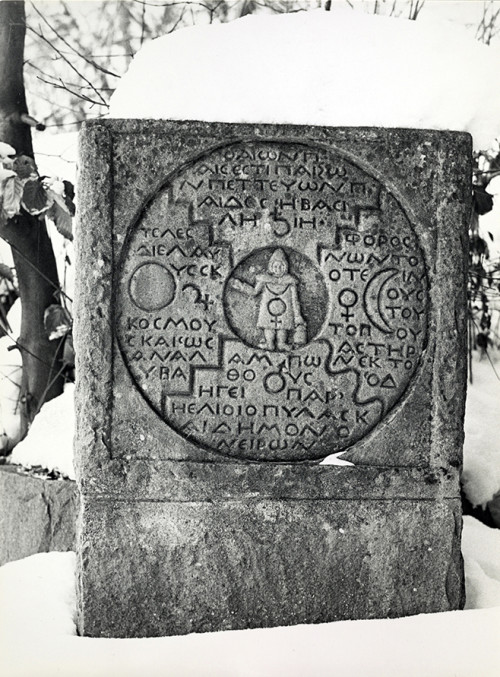Time is a child — playing like a child — playing a board game — the kingdom of the child. This is Telesphoros, who roams through the dark regions of this cosmos and glows like a star out of the depths. He points the way to the gates of the sun and to the land of dreams.
In 1950 I made a kind of monument out of stone to express what the Tower means to me. The story of how this stone came to me is a curious one. I needed stones for building the enclosing wall for the so-called garden, and ordered them from the quarry near Bollingen. I was standing by when the mason gave all the measurements to the owner of the quarry, who wrote them down in his notebook. When the stones arrived by ship and were unloaded, it turned out that the cornerstone had altogether the wrong measurements; instead of a triangular stone, a square block had been sent: a perfect cube of much larger dimensions than had been ordered, about twenty inches thick. The mason was furious and told the barge men to take it right back with them.
But when I saw the stone, I said, “No, that is my stone. I must have it!” For I had seen at once that it suited me perfectly and that I wanted to do something with it. Only I did not yet know what.
The first thing that occurred to me was a Latin verse by the alchemist Arnaldus de Villanova (died 1313). I chiseled this into the stone; in translation it goes:
Here stands the mean, uncomely stone,
‘Tis very cheap in price!
The more it is despised by fools,
The more loved by the wise.
This verse refers to the alchemist’s stone, the lapis, which is despised and rejected.
Soon something else emerged. I began to see on the front face, in the natural structure of the stone, a small circle, a sort of eye, which looked at me. I chiseled it into the stone, and in the center made a tiny homunculus. This corresponds to the “little doll” (pupilla) — yourself — which you see in the pupil of another’s eye; a kind of Kabir, or the Telesphoros of Asklepios. Ancient statues show him wearing a hooded cloak and carrying a lantern. At the same time he is a pointer of the way. I dedicated a few words to him which came into my mind while I was working. The inscription is in Greek; the translation goes:
Time is a child — playing like a child — playing a board game — the kingdom of the child. This is Telesphoros, who roams through the dark regions of this cosmos and glows like a star out of the depths. He points the way to the gates of the sun and to the land of dreams. 1)↓
These words came to me — one after the other — while I worked on the stone.
On the third face, the one facing the lake, I let the stone itself speak, as it were, in a Latin inscription. These sayings are more or less quotations from alchemy. This is the translation:
I am an orphan, alone; nevertheless I am found everywhere. I am one, but opposed to myself. I am youth and old man at one and the same time. I have known neither father nor mother, because I have had to be fetched out of the deep like a fish, or fell like a white stone from heaven. In woods and mountains I roam, but I am hidden in the innermost soul of man. I am mortal for everyone, yet I am not touched by the cycle of aeons.
In conclusion, under the saying of Arnaldus de Villanova, I set down in Latin the words “In remembrance of his seventy-fifth birthday C. G. Jung made and placed this here as a thanks offering, in the year 1950.”
When the stone was finished, I looked at it again and again, wondering about it and asking myself what lay behind my impulse to carve it.
The stone stands outside the Tower, and is like an explanation of it. It is a manifestation of the occupant, but one which remains incomprehensible to others. Do you know what I wanted to chisel into the back face of the stone? “Le cri de Merlin!” For what the stone expressed reminded me of Merlin’s life in the forest, after he had vanished from the world. Men still hear his cries, so the legend runs, but they cannot understand or interpret them.
Merlin represents an attempt by the medieval unconscious to create a parallel figure to Parsifal. Parsifal is a Christian hero, and Merlin, son of the devil and a pure virgin, is his dark brother. In the twelfth century, when the legend arose, there were as yet no premises by which his intrinsic meaning could be understood. Hence he ended in exile, and hence “le cri de Merlin” which still sounded from the forest after his death. This cry that no one could understand implies that he lives on in unredeemed form. His story is not yet finished, and he still walks abroad. It might be said that the secret of Merlin was carried on by alchemy, primarily in the figure of Mercurius. Then Merlin was taken up again in my psychology of the unconscious and — remains uncomprehended to this day! That is because most people find it quite beyond them to live on close terms with the unconscious. Again and again I have had to learn how hard this is for people.
C. G. Jung from “Memories, Dreams, Reflections”
| 1. | ↑ | The first sentence is a fragment from Heraclitus; the second sentence alludes to the Mithras liturgy, and the last sentence to Homer (Odyssey, Book 24, verse 12). |



